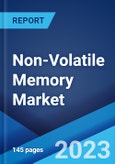The global non-volatile memory market size reached US$ 63.7 Billion in 2022. Looking forward, the publisher expects the market to reach US$ 125.8 Billion by 2028, exhibiting a growth rate (CAGR) of 11.39% during 2023-2028.
Non-volatile memory (NVM), also known as no-volatile storage, refers to a type of computer memory that can retain saved data even when the power is turned off. It does not require its data to be periodically refreshed and consequently finds extensive applications in retail, information technology (IT), telecommunications, automotive, and healthcare industries across the globe. Some of the commonly used NVM are read only memory (ROM), flash memory, hard disks, floppy disk drives, magnetic tapes, optical disc drives, and other computer storage methods, such as paper tapes and punch cards.
2. What is the expected growth rate of the global non-volatile memory market during 2023-2028?
3. What are the key factors driving the global non-volatile memory market?
4. What has been the impact of COVID-19 on the global non-volatile memory market?
5. What is the breakup of the global non-volatile memory market based on the type?
6. What is the breakup of the global non-volatile memory market based on the industry vertical?
7. What are the key regions in the global non-volatile memory market?
8. Who are the key players/companies in the global non-volatile memory market?
Non-volatile memory (NVM), also known as no-volatile storage, refers to a type of computer memory that can retain saved data even when the power is turned off. It does not require its data to be periodically refreshed and consequently finds extensive applications in retail, information technology (IT), telecommunications, automotive, and healthcare industries across the globe. Some of the commonly used NVM are read only memory (ROM), flash memory, hard disks, floppy disk drives, magnetic tapes, optical disc drives, and other computer storage methods, such as paper tapes and punch cards.
Non-Volatile Memory Market Trends:
There is a rise in the reliance on smartphones for communication and other purposes, which use advanced processors and NVM to enable fast data transfer. This, in confluence with the burgeoning electronics industry, represents one of the key factors impelling the growth of the market. Moreover, NVM is utilized in long-term or secondary data storage, such as memory chips for digital cameras and universal serial bus (USB) memory sticks. Besides this, there is an increase in the adoption of flash memory in laptops, global positioning systems (GPS), gaming devices, and electronic musical instruments on account of its lower price and power consumption. This, coupled with the rising usage of NVM in wearable devices, is positively influencing the market. Apart from this, the introduction of advanced storage technologies, such as 3D XPoint, magnetoresistive random-access memory (MRAM), and nano random-access memory (NRAM), is offering lucrative growth opportunities to market players. Furthermore, extensive research and development (R&D) activities undertaken by leading market players and rapid expansion of data centers around the world are anticipated to facilitate the growth of the industry.Key Market Segmentation:
The publisher provides an analysis of the key trends in each sub-segment of the global non-volatile memory market report, along with forecasts at the global, regional and country level from 2023-2028. The report has categorized the market based on type and industry vertical.Breakup by Type:
- Electrically Addressed
- Mechanically Addressed
- Others
Breakup by Industry Vertical:
- Telecom and IT
- Healthcare
- Automotive
- Consumer Electronics
- Energy and Power
- Others
Breakup by Region:
- North America
- United States
- Canada
- Asia-Pacific
- China
- Japan
- India
- South Korea
- Australia
- Indonesia
- Others
- Europe
- Germany
- France
- United Kingdom
- Italy
- Spain
- Russia
- Others
- Latin America
- Brazil
- Mexico
- Others
- Middle East and Africa
Competitive Landscape:
The competitive landscape of the industry has also been examined along with the profiles of the key players being Avalanche Technology, CrossBar Inc., Dialog Semiconductor PLC (Renesas Electronics Corporation), Fujitsu Limited, Honeywell International Inc., Infineon Technologies AG, Intel Corporation, Microchip Technology Inc., Micron Technology Inc., Samsung Electronics Co. Ltd., STMicroelectronics, Texas Instruments Incorporated, Toshiba Corporation, and Western Digital Corporation.Key Questions Answered in This Report
1. How big is the global non-volatile memory market?2. What is the expected growth rate of the global non-volatile memory market during 2023-2028?
3. What are the key factors driving the global non-volatile memory market?
4. What has been the impact of COVID-19 on the global non-volatile memory market?
5. What is the breakup of the global non-volatile memory market based on the type?
6. What is the breakup of the global non-volatile memory market based on the industry vertical?
7. What are the key regions in the global non-volatile memory market?
8. Who are the key players/companies in the global non-volatile memory market?
Table of Contents
1 Preface3 Executive Summary10 Value Chain Analysis12 Price Analysis
2 Scope and Methodology
4 Introduction
5 Global Non-Volatile Memory Market
6 Market Breakup by Type
7 Market Breakup by Industry Vertical
8 Market Breakup by Region
9 SWOT Analysis
11 Porters Five Forces Analysis
13 Competitive Landscape
Companies Mentioned
- Avalanche Technology
- CrossBar Inc.
- Dialog Semiconductor PLC (Renesas Electronics Corporation)
- Fujitsu Limited
- Honeywell International Inc.
- Infineon Technologies AG
- Intel Corporation
- Microchip Technology Inc.
- Micron Technology Inc.
- Samsung Electronics Co. Ltd.
- STMicroelectronics
- Texas Instruments Incorporated
- Toshiba Corporation
- Western Digital Corporation
Methodology

LOADING...
Table Information
| Report Attribute | Details |
|---|---|
| No. of Pages | 145 |
| Published | September 2023 |
| Forecast Period | 2022 - 2028 |
| Estimated Market Value ( USD | $ 63.7 Billion |
| Forecasted Market Value ( USD | $ 125.8 Billion |
| Compound Annual Growth Rate | 12.0% |
| Regions Covered | Global |
| No. of Companies Mentioned | 14 |









